Áo dài
The áo dài (English pronunciation: /ˈaʊˈdaɪ, ˈɔːˈdaɪ, ˈaʊˈzaɪ/; Vietnamese: [ʔaːw˧˦ zaːj˨˩] (North), [ʔaːw˦˥ jaːj˨˩] (South), Hán-Nôm: 襖𨱾)[1][2] is a traditional Vietnamese national garment. Besides suits and dresses nowadays, men and women can also wear áo dài on formal occasions. It is a long, split tunic worn over trousers. Áo translates as shirt.[3] Dài means "long".[4] The term can be used to describe any clothing attire that consists of a long tunic, such as "nhật bình".
The predecessor of the Áo dài was invented by the Nguyễn lords in Phú Xuân in the 18th century. This outfit evolved into the Áo ngũ thân, a five-paneled popular shirt worn in the 19th and early 20th centuries. Inspired by Paris fashions, Nguyễn Cát Tường and other Hanoi artists redesigned the ngũ thân as a modern dress in the 1920s and 1930s.[5] The updated look was promoted by the artists and magazines of Tự Lực văn đoàn (Self-Reliant Literary Group) as a national costume for the modern era. In the 1950s, Saigon designers tightened the fit to produce the version worn by Vietnamese women.[5] The ao dai dress for women was extremely popular in South Vietnam in the 1960s and early 1970s. On Tết and other occasions, Vietnamese men may wear an áo gấm (brocade robe), a version of the ao dai made of thick fabric.
The áo dài dress has traditionally been marketed with a feminine appeal, with "Miss Ao Dai" pageants being popular in Vietnam and with overseas Vietnamese.[6] However, the men version of ao dai or modified ao dai are also worn during weddings or formal occasions. The ao dai is one of the few Vietnamese words that appear in English-language dictionaries.[lower-alpha 1] The ao dai can be paired with the nón lá or the khăn vấn.
Parts of dress

- Tà sau: back flap
- Nút bấm thân áo: hooks used as fasteners and holes
- Ống tay: sleeve
- Đường bên: inside seam
- Nút móc kết thúc: main hook and hole
- Tà trước: front flap
- Khuy cổ: collar button
- Cổ áo: collar
- Đường may: seam
- Kích (eo): waist
Origin
Switch to trousers (18th century)
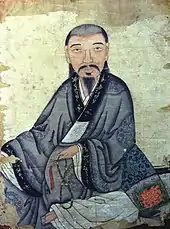
For centuries, peasant women typically wore a halter top (yếm) underneath a blouse or overcoat, alongside a skirt (váy).[7] Aristocrats, on the other hand, favored a cross-collared robe called áo giao lĩnh, which bore resemblance to historical Vietnamese clothing.[8][9] When the Ming dynasty occupied Đại Việt during the Fourth Era of Northern Domination in 1407, it forced the women to wear Chinese-style pants. The following Lê dynasty also criticized women for violating Confucian dress norms, but only enforced the dress code haphazardly, so skirts and halter tops remained the norm. During the 17th and 18th centuries, Vietnam was divided into northern and southern realms, with the Nguyễn lords ruling the south.[10] To distinguish the southern people from the northerners, in 1744, Lord Nguyễn Phúc Khoát of Huế decreed that both men and women at his court wear trousers and a gown with buttons down the front.[5][lower-alpha 2] The members of the southern court were thus distinguished from the courtiers of the Trịnh Lords in Hanoi, who wore áo giao lĩnh with long skirts.[8]
According to Lê Quý Đôn's record in the book "Phủ Biên Tạp Lục" (recording most of the important information about the economy and society of Đàng Trong for nearly 200 years), the Áo dài (or rather, the forerunner of the Áo dài) created by Lord Nguyễn Phúc Khoát based on Chinese Ming Dynasty costumes, by how to learn the method of making costumes in the book "Sāncái Túhuì" as the standard.[11]
19th century
The áo ngũ thân (five part dress) had two flaps sewn together in the back, two flaps sewn together in the front, and a "baby flap" hidden underneath the main front flap. The gown appeared to have two-flaps with slits on both sides, features preserved in the later ao dai. Compared to a modern ao dai, the front and back flaps were much broader and the fit looser and much shorter. It had a high collar and was buttoned in the same fashion as a modern ao dai. Women could wear the dress with the top few buttons undone, revealing a glimpse of their yếm underneath.
- Vietnamese garments throughout the centuries
 Tran dynasty robes as depicted in a section of a 14th-century scroll
Tran dynasty robes as depicted in a section of a 14th-century scroll Left: Illustration of a Vietnamese man (left) wearing the predecessor of áo dài in Sancai Tuhui, early 17th century during the Giao Chi or Jiaozhi era.
Left: Illustration of a Vietnamese man (left) wearing the predecessor of áo dài in Sancai Tuhui, early 17th century during the Giao Chi or Jiaozhi era. "Giảng học đồ" (Teaching), 18th century, Hanoi museum of National History. Scholars and students wear cross-collared gowns (áo giao lĩnh) - unlike the buttoned áo dài
"Giảng học đồ" (Teaching), 18th century, Hanoi museum of National History. Scholars and students wear cross-collared gowns (áo giao lĩnh) - unlike the buttoned áo dài Two women wear áo ngũ thân, the form of the ao dai worn in the nineteenth and early twentieth centuries illustrated on a postcard
Two women wear áo ngũ thân, the form of the ao dai worn in the nineteenth and early twentieth centuries illustrated on a postcard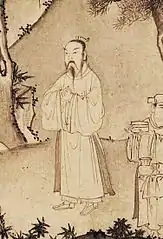 Trần Anh Tông wearing a "áo viên lĩnh" and outside a "áo giao lĩnh" in the calligraphy paintingTrúc Lâm đại sĩ xuất sơn đồ (The painting of Trúc Lâm the Great Master),14th century.
Trần Anh Tông wearing a "áo viên lĩnh" and outside a "áo giao lĩnh" in the calligraphy paintingTrúc Lâm đại sĩ xuất sơn đồ (The painting of Trúc Lâm the Great Master),14th century. Nón lá & Áo dài
Nón lá & Áo dài Áo Dài during Tết
Áo Dài during Tết
Modernization of style
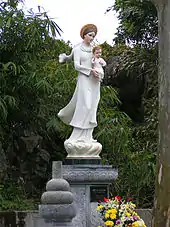
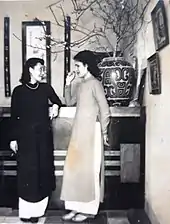
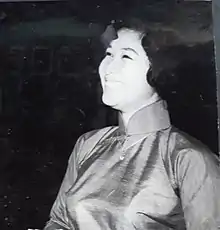
Huế's Đồng Khánh Girl's High School, which opened in 1917, was widely praised for the ao dai uniform worn by its students.[12] The first modernized ao dai appeared at a Paris fashion show in 1921. In 1930, Hanoi artist Cát Tường, also known as Le Mur, designed a dress inspired by the áo ngũ thân and by Paris fashions. It reached to the floor and fit the curves of the body by using darts and a nipped-in waist.[13] When fabric became inexpensive, the rationale for multiple layers and thick flaps disappeared. Modern textile manufacture allows for wider panels, eliminating the need to sew narrow panels together. The áo dài Le Mur, or "trendy" ao dai, created a sensation when model Nguyễn Thị Hậu wore it for a feature published by the newspaper Today in January 1935.[14] The style was promoted by the artists of Tự Lực văn đoàn ("Self-Reliant Literary Group") as a national costume for the modern era.[15] The painter Lê Phô introduced several popular styles of ao dai beginning in 1934. Such Westernized garments temporarily disappeared during World War II (1939–45).
In the 1950s, Saigon (now Ho Chi Minh City) designers tightened the fit of the ao dai to create the version commonly seen today.[5] Trần Kim of Thiết Lập Tailors and Dũng of Dũng Tailors created a dress with raglan sleeves and a diagonal seam that runs from the collar to the underarm.[5] Madame Nhu, first lady of South Vietnam, popularized a collarless version beginning in 1958. The ao dai was most popular from 1960 to 1975.[16] A brightly colored áo dài hippy was introduced in 1968.[17] The áo dài mini, a version designed for practical use and convenience, had slits that extended above the waist and panels that reached only to the knee.[13]
Communist period
The ao dai has always been more common in the South than in the North. The communists, who gained power in the North in 1954 and in the South in 1975, had conflicted feelings about the ao dai. They praised it as a national costume and one was worn to the Paris Peace Conference (1969–73) by Vietcong negotiator Nguyễn Thị Bình.[18] Yet Westernized versions of the dress and those associated with "decadent" Saigon (Ho Chi Minh City) of the 1960s and early 1970s were condemned.[19] Economic crisis, famine, and war with Cambodia combined to make the 1980s a fashion low point.[20] The ao dai was rarely worn except at weddings and other formal occasions, with the older, looser-fitting style preferred.[19] Overseas Vietnamese, meanwhile, kept tradition alive with "Miss Ao Dai" pageants (Hoa Hậu Áo Dài), the most notable one held annually in Long Beach, California.[5]
The ao dai experienced a revival beginning in late 1980s, when state enterprise and schools began adopting the dress as a uniform again.[5] In 1989, 16,000 Vietnamese attended a Miss Ao Dai Beauty Contest held in Ho Chi Minh City.[21] When the Miss International Pageant in Tokyo gave its "Best National Costume" award to an ao dai-clad Trường Quỳnh Mai in 1995, Thời Trang Trẻ (New Fashion Magazine) claimed that Vietnam's "national soul" was "once again honored".[22] An "ao dai craze" followed that lasted for several years and led to wider use of the dress as a school uniform.[23]
Present day

No longer deemed politically controversial, ao dai fashion design is supported by the Vietnamese government.[20] It is often called áo dài Việt Nam to link it to patriotic feelings. Designer Le Si Hoang is a celebrity in Vietnam and his shop in Ho Chi Minh City is the place to visit for those who admire the dress.[20] In Hanoi, tourists get fitted with ao dai on Luong Van Can Street.[24] The elegant city of Huế in the central region is known for its ao dai, nón lá (lit. 'traditional leaf hat'), and well-dressed women.
The ao dai is now a standard for weddings, for celebrating Tết and for other formal occasions. It's the required uniform for female teachers (mostly from high school to below) and female students in common high schools in the South; there is no requirement for color or pattern for teachers while students use plain white with some small patterns like flowers for school uniform and in many Vietnamese high schools, female students are required to wear ao dai on one day is Monday. Companies often require their female staff to wear uniforms that include the ao dai, so flight attendants, receptionists, bank female staff, restaurant staff, and hotel workers in Vietnam may be seen wearing it.
The most popular style of ao dai fits tightly around the wearer's upper torso, emphasizing her bust and curves. Although the dress covers the entire body, it is thought to be provocative, especially when it is made of thin fabric. "The ao dai covers everything, but hides nothing", according to one saying.[18] The dress must be individually fitted and usually requires several weeks for a tailor to complete. An ao dai costs about $200 in the United States and about $40 in Vietnam.[25]
"Symbolically, the ao dai invokes nostalgia and timelessness associated with a gendered image of the homeland for which many Vietnamese people throughout the diaspora yearn," wrote Nhi T. Lieu, an assistant professor at the University of Texas at Austin.[6] The difficulties of working while wearing an ao dai link the dress to frailty and innocence, she wrote.[6] Vietnamese writers who favor the use of the ao dai as a school uniform cite the inconvenience of wearing it as an advantage, a way of teaching students feminine behavior such as modesty, caution, and a refined manner.[23]
The ao dai is featured in an array of Asian-themed or related movies. In Good Morning, Vietnam (1987), Robin Williams's character is wowed by ao dai-clad women when he first arrives in Ho Chi Minh City. The 1992 films Indochine and The Lover inspired several international fashion houses to design ao dai collections,[26] including Prada's SS08 collection and a Georgio Armani collection. In the Vietnamese film The White Silk Dress (2007), an ao dai is the sole legacy that the mother of a poverty-stricken family has to pass on to her daughters.[27] The Hanoi City Complex, a 65-story building now under construction, will have an ao dai-inspired design.[28] Vietnamese designers created ao dai for the contestants in the Miss Universe beauty contest, which was held July 2008 in Nha Trang, Vietnam.[29] The most prominent annual Ao Dai Festival outside of Vietnam is held each year in San Jose, California, a city that is home to a large Vietnamese American community.[30] This event features an international array of designer ao dai under the direction of festival founder, Jenny Do.
In recent years, a shorter, more modern version of the ao dai, known as the áo dài cách tân, is often worn by the younger generation. This modern ao dai has a shorter front and back flap, hitting just below the knees.
Gallery
 Young girls in áo dài by the Hoan Kiem Lake.
Young girls in áo dài by the Hoan Kiem Lake. Two highschool girls in áo dài in HCMC
Two highschool girls in áo dài in HCMC.jpg.webp) A woman wearing an áo dài at the Huế citadel
A woman wearing an áo dài at the Huế citadel.jpg.webp) A woman wearing an áo dài sitting in a chair
A woman wearing an áo dài sitting in a chair.jpg.webp) A woman wearing an áo dài
A woman wearing an áo dài.jpg.webp) A woman sitting on the steps wearing an áo dài
A woman sitting on the steps wearing an áo dài Áo dài and khăn vấn wedding attire
Áo dài and khăn vấn wedding attire Men in formal attire-Marie Antoinette Boullard-Devé
Men in formal attire-Marie Antoinette Boullard-Devé Old man wearing traditional áo dài and khăn vấn in Saigon, Tết 1963
Old man wearing traditional áo dài and khăn vấn in Saigon, Tết 1963 Five sisters in Hanoi 1950s
Five sisters in Hanoi 1950s At the gallery of Hanoi in 1930
At the gallery of Hanoi in 1930
See also
- Culture of Vietnam
- Shanku, Hanfu, Cheongsam, paofu – Traditional Chinese clothing
- Hanbok - Traditional Korean clothing
- Kimono - Traditional Japanese garment
Notes
- "Ao dai" appears in the Oxford English Dictionary, the American Heritage Dictionary (2004), and the Random House Unabridged Dictionary (2006). Other Vietnamese words that appear include "Tet", "Vietminh", "Vietcong", and "pho" (rice noodles).
- A court historian described the dress in Huế as follows: "Outside court, men and women wear gowns with straight collars and short sleeves. The sleeves are large or small depending on the wearer. There are seams on both sides running down from the sleeve, so the gown is not open anywhere. Men may wear a round collar and a short sleeve for more convenience." ("Thường phục thì đàn ông, đàn bà dùng áo cổ đứng ngắn tay, cửa ống tay rộng hoặc hẹp tùy tiện. Áo thì hai bên nách trở xuống phải khâu kín liền, không được xẻ mở. Duy đàn ông không muốn mặc áo cổ tròn ống tay hẹp cho tiện khi làm việc thì được phép…") (from Đại Nam Thực Lục [Records of Đại Nam])
References
- "Definition of ao dai | Dictionary.com". www.dictionary.com.
- "Ao dai definition and meaning | Collins English Dictionary". www.collinsdictionary.com.
- Áo is derived from a Middle Chinese word meaning "padded coat". "ao dai", definition of ao dai in Oxford dictionary (British & World English). Retrieved November 3, 2014.
- Phan Van Giuong, Tuttle Compact Vietnamese Dictionary: Vietnamese-English English-Vietnamese (2008), p. 76. "dài adj. long, lengthy."
- Ellis, Claire (1996). "Ao Dai: The National Costume". Things Asian. Archived from the original on July 5, 2008. Retrieved August 2, 2008.
- Lieu (2000), p. 127–151.
- Niessen, Leshkowich & Jones (2003), p. 89.
- Vu, Thuy (2014). "Đi tìm ngàn năm áo mũ". Tuoi Tre. Archived from the original on June 17, 2015. Retrieved June 16, 2015.
- T.Van (2013). "Ancient costumes of Vietnamese people". Vietnamnet. Retrieved June 16, 2015.
- Leshkowich 2005, p. 61.
- Đàng Trong costume in the reign of Lord Nguyễn Phúc Khoát - outstanding features
- Kauffner, Peter. "Ao dai: The allure and grace of Vietnam's traditional dress Archived May 22, 2013, at the Wayback Machine", Asia Insights: Destination Asia, September–October 2010
- Niessen, Leshkowich & Jones (2003), p. 91.
- "A Fashion Revolution". Ninh Thuận P&T. Archived from the original on June 23, 2008. Retrieved August 2, 2008.. For a picture of the áo dài Le Mur, see Ao Dai — The Soul of Vietnam.
- "Vietnamese Ao dai history". Aodai4u. Retrieved August 2, 2008.
- Elmore, Mick (September 17, 1997). "Ao Dai Enjoys A Renaissance Among Women : In Vietnam, A Return to Femininity". International Herald Tribune.
- Bich Vy-Gau Gi, Ao Dai — The Soul of Vietnam. Retrieved on July 2, 2008.
- "Vietnamese AoDai". Overlandclub. Archived from the original on March 19, 2008. Retrieved July 2, 2008.
- Niessen, Leshkowich & Jones (2003), p. 92.
- Valverde, Caroline Kieu (2006). "The History and Revival of the Vietnamese Ao Dai". NHA magazine. Archived from the original on July 4, 2008. Retrieved August 2, 2008.
- Vu, Lan (2002). "Ao Dai Viet Nam". Viettouch. Retrieved July 3, 2008.
- Niessen, Leshkowich & Jones (2003), p. 79.
- Niessen, Leshkowich & Jones (2003), p. 97.
- "Traditional ao dai grace foreign bodies". VNS. December 20, 2004. Archived from the original on December 24, 2004. Retrieved August 24, 2016.
- "Ao Dai Couture". Nha magazine. Archived from the original on April 8, 2008. Retrieved August 12, 2008.
- "Ao Dai – Vietnamese Plus Size Fashion Statement". Archived from the original on February 16, 2009. Retrieved July 14, 2008.
- "Vietnam send Ao Lua Ha Dong to Pusan Film Festival". VietNamNet Bridge. 2006. Retrieved July 13, 2008.
- Tuấn Cường. ""Nóc nhà" Hà Nội sẽ cao 65 tầng". Tuoi Tre (in Vietnamese). Retrieved April 26, 2009.
- "Miss Universe contestants try on ao dai". Vietnam.net Bridge. 2008. Archived from the original on July 1, 2008. Retrieved August 2, 2008.
- "| A Celebration of Vietnamese Art and Culture". Ao Dai Festival.
Bibliography
- Leshkowich, Ann Marie (2005). Encyclopedia of Clothing and Fashion.
- Li, Tana (1998). Nguyễn Cochichina: Southern Vietnam in the Seventeenth and eighteenth centuries. Southeast Asia Program Publications. ISBN 9780877277224.
- Lieu, Nhi T. (2000). "Remembering 'the Nation' through pageantry: femininity and the politics of Vietnamese womanhood in the 'Hoa Hau Ao Dai' contest". Frontiers: A Journal of Women Studies. University of Nebraska Press. 21 (1–2): 127–151. doi:10.2307/3347038. JSTOR 3347038.
- Niessen, S. A.; Leshkowich, Ann Marie; Jones, Carla, eds. (2003). Re-Orienting Fashion: The Globalization of Asian Dress. Berg. p. 89. ISBN 978-1-85973-539-8.
Further reading
External links
![]() Media related to Áo dài at Wikimedia Commons
Media related to Áo dài at Wikimedia Commons
- History of the Vietnamese Long Dress
- The Evolution of the Ao Dai Through Many Eras, Gia Long Alumni Association of Seattle, 2000
- Vietnam: Mini-Skirts & Ao-Dais. A video that shows what the women of Saigon wore in 1968
.jpg.webp)


_colour_scheme_-_%C4%90%E1%BA%A1i_Nam_(%E5%A4%A7%E5%8D%97).svg.png.webp)